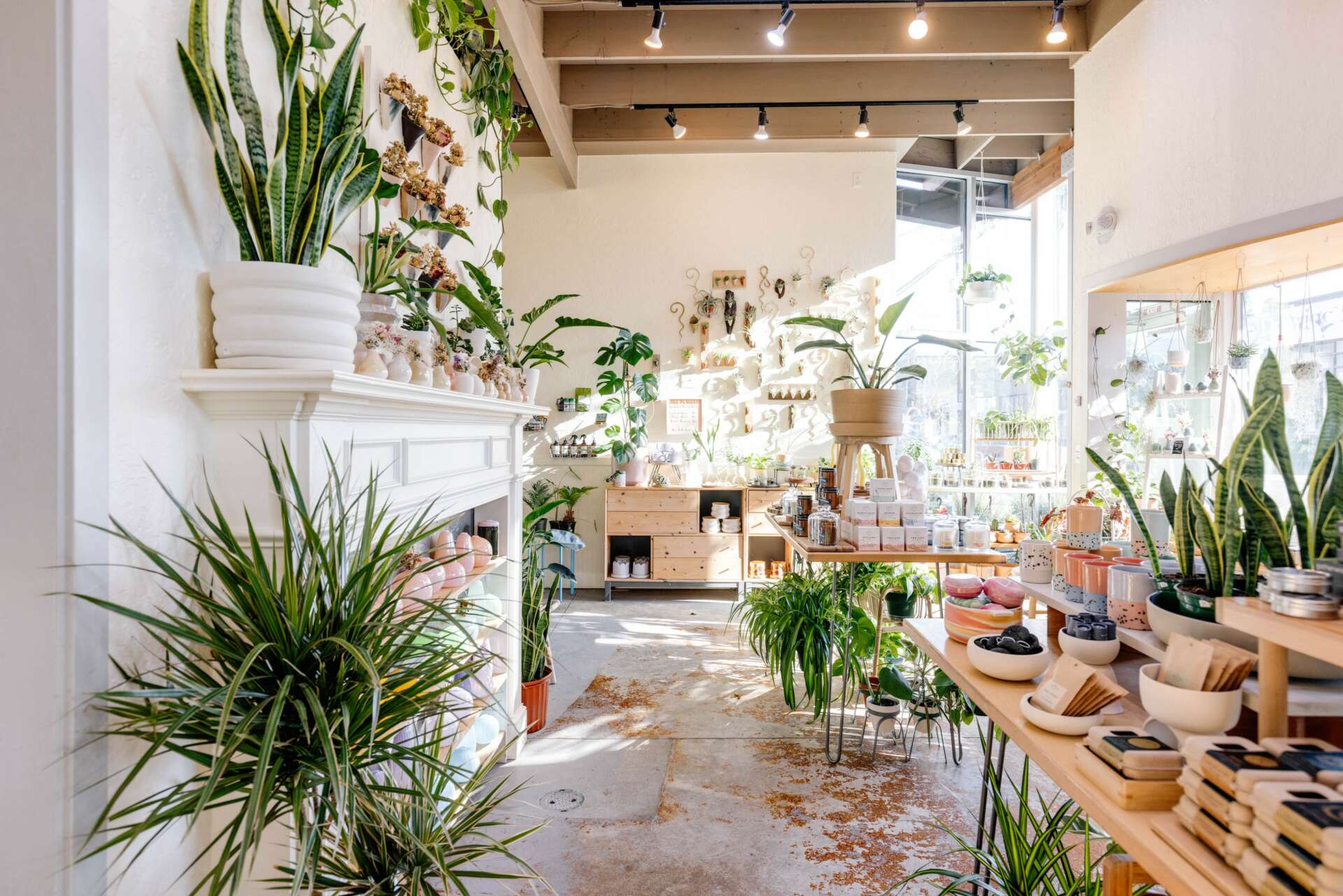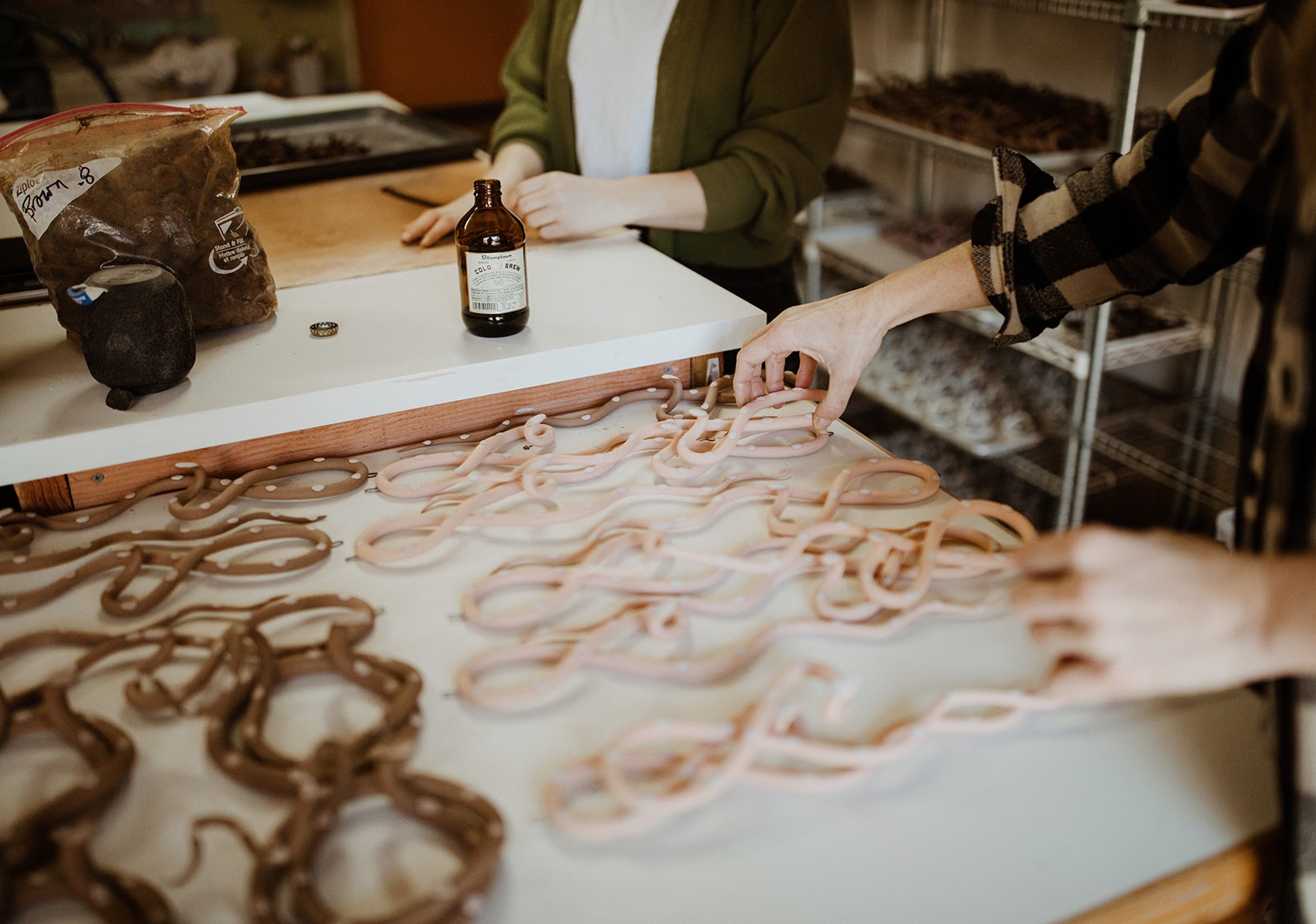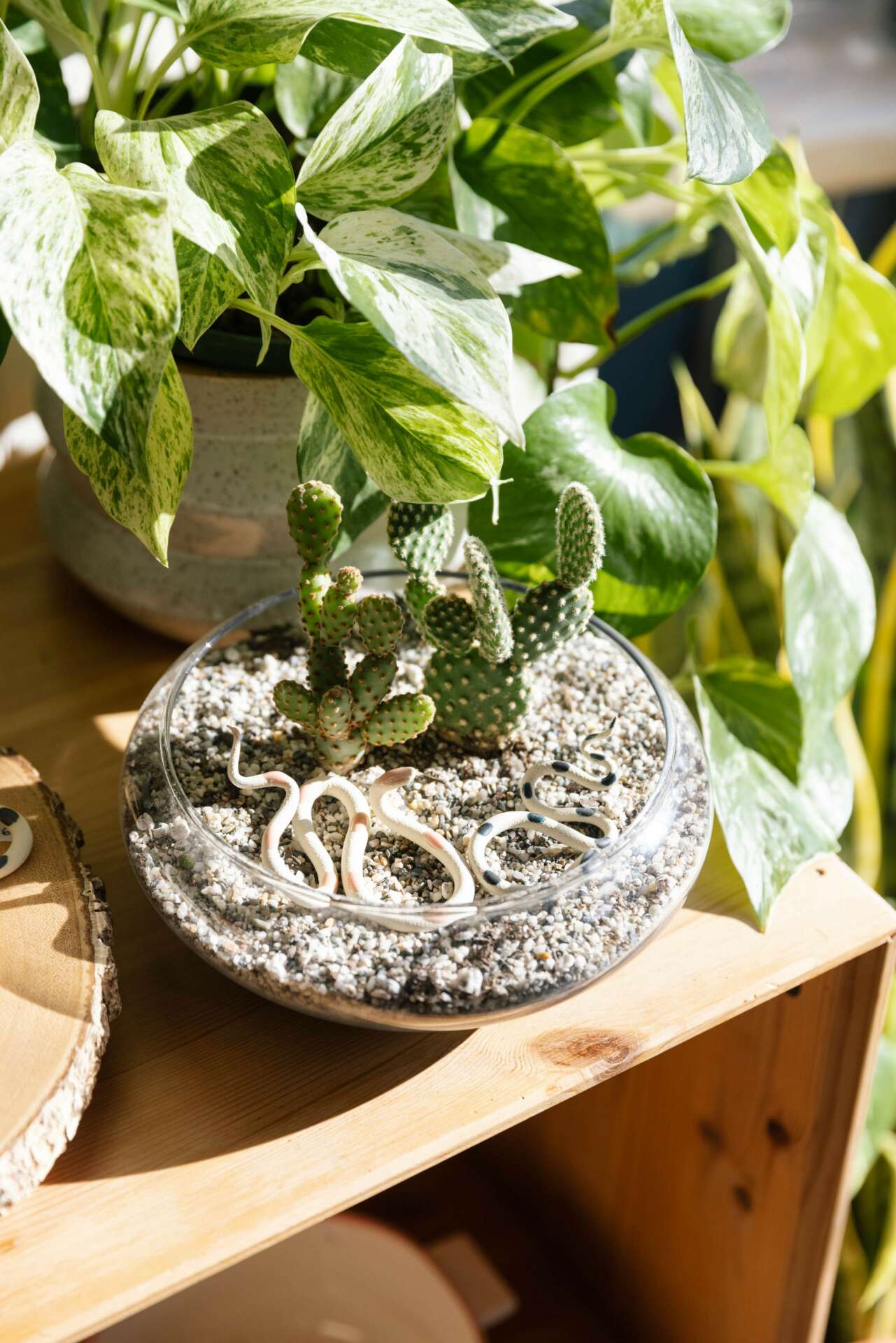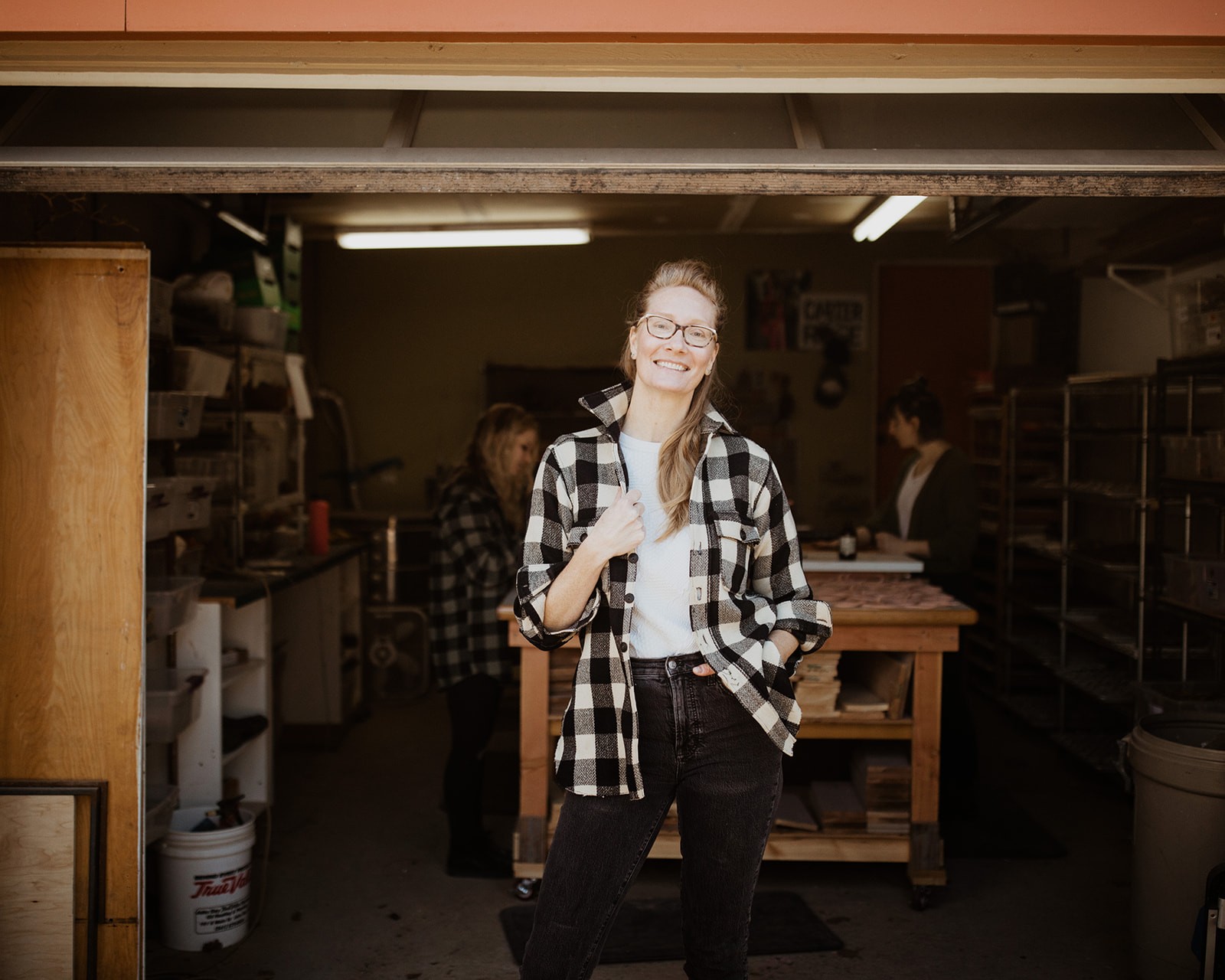Alright – so today we’ve got the honor of introducing you to Anna VonRosenstiel. We think you’ll enjoy our conversation, we’ve shared it below.
Anna, appreciate you joining us today. Risk taking is something we’re really interested in and we’d love to hear the story of a risk you’ve taken.
The story of Carter + Rose is multilayered, comes from many places, and has evolved and changed over the years. I grew up in a creative household; my dad is a builder and furniture designer. A lot of my time was spent with my brother in my dad’s shop and he let us have free range over the scrap wood, hammer, nails, and hot glue gun as long as we didn’t complain. We were an adventurous family and very hands-on with camping, skiing, and traveling.
The ability to make things and be creative was just a part of everyday life, and that sense of creativity followed me through school and into my first jobs. Although I was an English major, I always took art classes and had my sewing machine set up on my dorm room floor. In my time off I watercolored, knit, and taught myself how to batik. Later on, I went back to school with the goal of someday teaching art. My first job was at an elementary school and I found a ceramic kiln in the janitor’s closet. That is really where the story of my clay and ceramics journey begins.
I started making clay projects with all of my students and bravely ran the kiln for the first time (checking on it at least 5 times just to be sure the school wasn’t burning down). I made my first set of dishes that month, applied to an art fair, got in, and immediately panicked! But I followed through and set up my first art fair booth that summer. I was immediately hooked. I loved clay, I loved meeting my customers, I loved meeting other artists, and I loved selling. After that first fair, I applied to 2-3 fairs every summer and we all (my husband and eventually kids) would drive, set up, sell, and drive home like yo-yos.
Carter + Rose was born out of an extension of this love of creativity and the desire to continue to be fully immersed in a creative community. Initially, the Carter + Rose wholesale line and Carter + Rose storefront were a dream that a friend, Liz, and I had together. We had a common love of making. In Liz, I had found someone who was equally drawn to making, producing, learning, and creating. As we worked together, we started envisioning a store that we could build as a team. We talked endlessly about what we would sell, where the store would be, and what kind of products we would develop in our studio.
In September 2014, Liz called and asked me, “Do you really want to open a store?” I had just had my second baby, I wasn’t working, and I was getting antsy being at home. Honestly, I didn’t even think. I just said, “Yes!” I had the time. I had a want. And, she was ready for a change too. The timing seemed perfect, so I immediately started looking for a space to open a storefront. We talked daily and were immensely excited. What should we name it? What will we make? What font should we use for our business cards? How do we make a logo? Where do we get business cards? What are we doing?? We were both so excited and committed to the idea of making this dream happen that we just grabbed hands and jumped in.
We started Carter + Rose from the ground up. Each thing, everyday, was new and we did the work. The tasks were endless and varied. Our ideas were endless and varied. Our main goal was to open a storefront where we could sell our own products as well as the products of other artists. So, we painted the walls, added a big window, built display tables, and came up with product ideas. I was a new mom and Liz was new to Portland. We were navigating starting a business together, and also navigating new lives personally. Being good friends helped, but it was also stressful to worry about our business’ success, make sure we were balanced, and that our relationship didn’t get strained.
We didn’t start a brick and mortar shop in a traditional, straight forward way. We didn’t have a ton of money to put into it, but we did have time, energy, and endless ideas. We also had an amazing set of skills between us: we were a florist, business owner, painter, mix-media artist, teacher, ceramicist, therapist, saleswoman… and, we were scrappy. To make things less overwhelming, we used what we had. We refurbished furniture we found on the side of the street to use as store displays and we dug through Goodwill bins for display pieces and then gold leafed them.
Instead of trying to have a grand opening where we unveiled a finished store, we worked with what we had and initially opened the storefront a few days a week for a few hours as an “open clay studio.” During Open Clay Studio, anyone could come in and make things out of clay. Initially, opening up the studio simply helped us pay the rent. Later, it also helped us buy our own clay, glaze, wood, and other supplies to start creating our products and experimenting with ideas.
The craziest thing to me, looking back, is that we were not only starting a brick and mortar store from scratch, but we were also creating a product line from scratch as well. Our vision was broad: open a store and fill it with the things we make. We had to be flexible, creative, adaptive, and also very willing to throw out ideas that weren’t working.
In December 2014, we decided to open as a small pop-up store to test and sell some of the things we had made: jewelry, mirrors, signs, wall planters, hand towels, and dishes. Based on these initial December sales, it was obvious that the wall planter was the item that we should focus on making and refining. By continuing to stay focused on refining the wall planter as a product, and using the materials and skills we had, we continued working on the store and fully opened Carter + Rose in June 2015, showcasing the wall planter as our main product line.
Around this time, we were also approached by the West Elm Local program. They were interested in featuring us as one of their Portland artists for their downtown location. This opportunity wasn’t just flattering, it was a crash course in creating a wholesale product line. We quickly realized that we needed to streamline how we measured, weighed, painted, and implemented all aspects of our wall planter. And we needed to fill out an incredible amount of paperwork! But this process helped focus us and helped us further engage with the process of fully implementing and creating a product, especially for wholesale.
Because of my prior relationships with local artists from summer art fairs, we were easily able to incorporate other artist’s work into the store as well, defining Carter + Rose from the beginning as a maker’s store and studio. However, it is a challenge to continually find products that are the perfect fit for the store: beautiful, handmade, and a shoppable price point. But, because I travel for craft shows, I often use the opportunity as a way to sell my wares, but also to find and buy work from other makers. I like the opportunity to see the products first hand, and really think about how the product will be seen, held, and purchased by my customers. And, because we make things, we truly understand the quality of handmade.
Not only am I always on the lookout for great products for the store, I also love knowing the story about the person behind the product. I think that knowing who makes our products helps sell the products. When customers come in and ask about certain things we carry, it always helps to know as much about the product as well as the person and company behind it.
Most of the time, I will bring in a small quantity of an artist’s work and give it a test run in the store. It becomes obvious fairly quickly what products do well. The season also matters. During the summer, we have to keep in mind that tourists are coming to Portland and are especially interested in buying local, handmade goods. So, we focus on carrying lots of packable gifts and locally made items. During the winter, we focus on the holidays and giving. It is a safer time to bring in higher priced items because people tend to have budgets for gifting versus just buying for themselves.
Keeping business coming in was always at the front of our minds when envisioning Carter + Rose. We built the business in a multifaceted way to ensure we always had multiple revenue streams that we could rely on. Those revenue streams ebb and flow, and help support Carter + Rose in waves, depending on the season. During the winter when people need things to do, Open Clay was busy and thriving. During the summer when tourists are flocking to Division Street, our in-store sales are great. And summer and pre-holiday are also good for online sales. We started with three revenue streams for Carter + Rose: a brick and mortar space selling handmade products, classes and studio time in that space, and showcasing our products at craft shows. Eventually, we added wholesale accounts and we are currently working on increasing our online presence. And because of COVID, we shut down the clay studio aspect- it was too daunting to handle.
Of course, in the world of two-day shipping and online shopping, the struggle of connecting with walk-in customers and making daily sales goals is real! There are a limited number of people in the neighborhood who need birthday gifts and we don’t know how many tourists are going to walk down Division Street on the weekends. But I try to make Carter + Rose stand out and be noticed.
Online, our focus is on our Instagram, TikTok and Pinterest profile. They help us showcase our aesthetic. We try to make these digital platforms reflections of an instore Carter + Rose experience.
As we have grown, we have also increased the number of craft shows that we do. I feel a sense of excitement when we are in California vending and someone sees our booth and says, “Oh look, it’s Carter + Rose, that cute store I visited in Portland!” I think having a product associated with our store only strengthens our brand and gets people more interested in visiting our brick and mortar location for a more personal experience.
Now, day to day shop life is like a tornado. I usually try to catch up on any emails in the morning right after the kids go to school, and then I revisit emails later in the evening. During a typical day, I focus mostly on making our products. I go to the lumber yard, buy wood, chop wood, sand, glaze, and nail. I work with my studio assistant to come up with new colorways. I clean paint brushes. I go to the local clay store to buy clay and glazes. I fill out applications for shows, I train employees on new store standards, I research new products for the store, I worry about payroll, and I make lots of coffee. I input receipts, go to the bank, drop off wholesale orders, package up online orders, ship orders, and print labels and packing slips. I also host special events and private parties. Hopefully, somewhere in between all of these things, I have a sandwich.
I think the biggest day to day challenge is trying to balance having a storefront that I want to keep fresh and interesting, and also being very involved in my own product’s evolution. They are both reflections of my business and it’s hard to find the time to continually be thoughtful about them both. So day to day, I remind myself to focus on the most crucial task at hand, and I’m working really hard on asking for help and delegating tasks.
Shortly after opening, Liz needed to move home to be closer to her family. So honestly, one of the hardest parts of starting Carter + Rose was this moment: this transition. We had only been open for about 6 months. We had put so much sweat and love and time into creating this vision that we had talked about for years and years. And all of a sudden, Liz needed to leave. It was a jolt. After what seemed like a million conversations, we decided that I would keep the business and continue running it as sole proprietor.
Over beers and tater tots, we drew up an agreement that seemed fair based on our time, and then, just like that, Liz left Portland and I kept going. I had to adjust running a business that we had built based on two owners into a one owner role. The craziest thing is, Liz and I still love each other and talk often and see each other every year, just as we always have. So for Liz and me, our friendship will always be there—before, during, and after Carter + Rose.
When Liz left, I also had to increase the staffing at the store so I could focus more on the production side of the business. And, eventually, as our wholesale grew, I stepped away from working at the store all together. This was tough. Handing over the day to day operations of the store to my employees felt like a giant leap of faith. Would they notice all the details? Are earrings crooked on display, is there dust on the candle lid, are wall planters missing plants, are we low on bags, is the heat turned on, are there phone messages, is the floor dusty, did the garbage go out? All of these things run through my head daily, hourly, and by the minute. I had to learn how to quiet them. And I had to learn to trust that other people could take care of them. Maybe not 100% like I would, but close enough. I also had to learn that it’s okay to let go a bit. In fact, it’s amazing to give my employees a more serious set of responsibilities within the company.
There’s a theory that ceramicist deal with disappointment well and adapt well because so much of what happens during the process of making things. Clay is fragile; things can break, crack, or explode in an instant. And once that happens, you just have to move on. I have come to the realization that owning a small business is similar. There are so many moments that feel like a wall is cracking open. But then, just like watching a row of wall planters fall to the floor and break into a million pieces, I take a moment, assess what’s happening, make some adjustments, and then realize that with a broom and a dustpan, the mess gets cleaned up. And in the cleaning process, I learned a lot. The feeling of disappointment (and sometimes failure) passes and then it’s okay.
Change and growth can also be uncomfortable. I used to roll my eyes at this, but now, I just roll with it. When I have moments of panic (most recently with the idea of expanding our online sales and streamlining shipping) I realize that if I feel panic or uncertainty while at the same time feeling motivated and inspired, the feeling to trust is the motivation. I may not know what the outcome will be, but I can tell myself for certain at this point, after owning a store for 4 years, there has never been a positive growth spurt without some serious soul searching and tears.
I think that turning my passion into a profession was the biggest risk I have taken in my life. Flexibility and adaptability based on what is needed to be successful was be surprising and delightful and sometimes lead down paths that were unexpected. I don’t think that I ever compromised the vision and feeling of Carter + Rose in its inception and as it has grown. However, there were times that it was obvious that something I was insistent was a good idea was not connecting or growing. In this way, I think it was really important to focus on moving forward toward success and not letting the idea of failure get into my head. Part of that was being aware, adapting, continually questioning, and willing to take calculated risks with incredible amounts of optimism. A big part of what gave us the guts to open a storefront was that we never even entertained the idea that it wouldn’t work.
I also believe that Carter + Rose is partially a success because it is genuine and committed to being a positive, beautiful force in the community. For me, running Carter & Rose is an extension of my life and my outlook. Being an artist is about seeing creativity all around, all the time, and passing it on in big and small ways. I am proud to be raising two tough, creative, smart, and funny daughters who make more of a mess in my studio than I do. I love that Carter + Rose supports artists, and I love that it lets me hang out in my studio, making things. From passion to profession, Carter & Rose was easily entangled into my already established life and the lives of my family.
Looking back, the Carter + Rose of 2015 feels like the beautiful, grungy, optimistic little sister to the Carter + Rose today. We now have matching shelving displays. Our wholesale line of wall planters and ceramic snakes is cohesive and thoughtful. Looking at the branding, Instagram, website, and storefront, Carter + Rose doesn’t feel like a brick and mortar store born out of sawdust and refurbished furniture, but it is. And to me that is what makes Carter + Rose so authentic and real. It was built by hands and dreams and super hard work.


Great, appreciate you sharing that with us. Before we ask you to share more of your insights, can you take a moment to introduce yourself and how you got to where you are today to our readers.
I think I hit on this in my rambling first answer, BUT, if I can add to it:
I have continually worked to expand Carter + Rose’s product line. During COVID I had to be creative with using my time well and coming up with ideas for keeping Carter + Rose relevant. Our ceramic snake line was born during the pandemic and honestly, it grew so quickly it became the backbone of the business and kept us afloat while the world shut down. I am proud that I am able to jump on an idea, see if it catches, and run with it. I am also proud that if something doesn’t quite work, I can let it go and move on with other ideas. Carter + Rose is truly a test kitchen for ceramics.


How do you keep your team’s morale high?
I believe that each person that works for me has a superpower. Sometimes it’s not completely clear to me right away how someone will fit perfectly into the Carter + Rose team, but after a bit of time, I love figuring out how to best use the skills and strengths of each person on my team. I work closely with each person on the team and really try to make their role fit them best as possible. I feel like there is flexibility in the vision of Carter + Rose and I can ebb and flow with the team of people I have. On a very basic level, I also make sure to compliment jobs well done, and let my team know I appreciate them.


How about pivoting – can you share the story of a time you’ve had to pivot?
The pandemic was our biggest pivot. We had to close the store and stop doing open clay studio. The pandemic forced me to focus more effort into our website and social media. With a small business grant, I was able to work on our website and drive more traffic for online sales. I also had endless time in my studio and spent each day focusing on the creative process. I used the time to reach out to our social media audience, “teach” ceramic lessons through Instagram, and come up with new products. It was during COVID, that our newest and most popular product was born: the ceramic snake. I was trimming plates for a restaurant and the little squiggle of clay that came off looked like a snake. I built an entire line around the ceramic snake and it was this product that completely supported the success of Carter + Rose during the pandemic. The ceramic snake launched Carter + Rose into a new wholesale realm as well. All of a sudden, with the store closed and classes discontinued, our wholesale took off and became my complete focus.


Contact Info:
- Website: carterandrose.com
- Instagram: @carterandrosepdx
- TikTok: @carterandrose.pdx
Image Credits
Brady Bates, Amanda Proudfit


